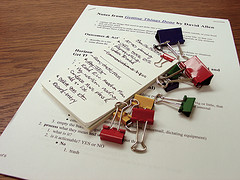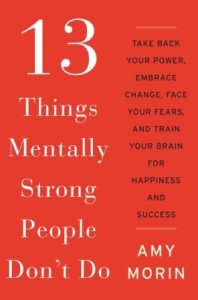
Bind It Up: DIY Planner Binding Options
Mondays are productivity days at SimpleProductivity blog.
Once you decide to make your own planning system, the binding becomes the first matter of choice. It dictates the size of your pages, as well as any special equipment you might need. Today we will look at the various binding options and how they work with different DIY options.
Size Matters
The main thing that is going to drive your binding choice is how much material you will be holding together.
If you are a true minimalist and only want a page for the day, and a task list, you could get away with a paper clip. If you want to have a full month’s worth of pages, plus project pages, plus task lists, you are going to need something more substantial.
Figure out wha you would use on a daily basis, and approximately how many sheets this would be.
Small Bindings
If you have a small amount of papers, these options are a possibility for you:
- Clips. Binder clips are strong, and come in a variety of sizes. They can handle holding together various amounts of paper with ease. Advangate: easily obtainable, and allow quick rearranging of the pages. Disadvantage: when the clip is off, all the pages are loose.
- Bands. When combined with a sturdy plastic or cardboard cover, one rubber band or hair elastic can hold a group of papers together. Advantage: easily obtainable, and allows for quick rearranging of the pages. Disadvantage: if the band is too small, it can cause “bowing” of the system.
- Spiral. If you have access to a binding machine, either commercially or through your employer, you can bind pages together. Advantage: a sturdy binding. Disadvantage: no movement of the pages is easy once the binding is in place; and you are limited to letter size paper pages.
Ring Binders
Another common option is the ring binder. Whether a generic binder with 3 rings, or the special planning binder with 5 or 7 rings, you can find a wide variety of binders in many page sizes and covers.
Binders come in various circumferences, too, and this can help you with any amount of paper you want to carry.
Most office supply stores not only carry the paper-sized binders in a huge array, but also various smaller sized ring binders in the planner section.
With a ring binder, you will have to purchase a paper punch to allow you to put your own forms into the system. This could be inexpensive, if you go for the standard 3-ring punch, or it could be very expensive if you decide to go with a 5- or 7- ring option, which can only be purchased from certain specialty stores or online.
Circa
Circa is a system where pages are mounted on solid disks that have a lip to allow the pages to spin. Each “hole” is actually mushroom-shaped, and the straight edges keep the paper on the disk, which the cap of the mushroom spins around the lip of the disk.
Circa is a good option for left-handed people, because the disks don’t intrude on the writing surface as badly as the binders.
However, Circa can be expensive with the punches, and I have only found one reliable distributor in the US – Levenger (I have tried the other supplier and had less-than-stellar service and delivery problems). However, Levenger does make it easy to get started with the system, both with a $10 5.5″ x 8.5″ starter kit, and a full starter kit with various sizes that comes with a gift card that covers its cost.
When you decide to do a DIY planner, the first decision you need to make is how you will bind it. There are options ranging from the very simple to the highly complex.
What is your favorite binding? Share below.
Photo by Teo. Licensed under Creative Commons.




